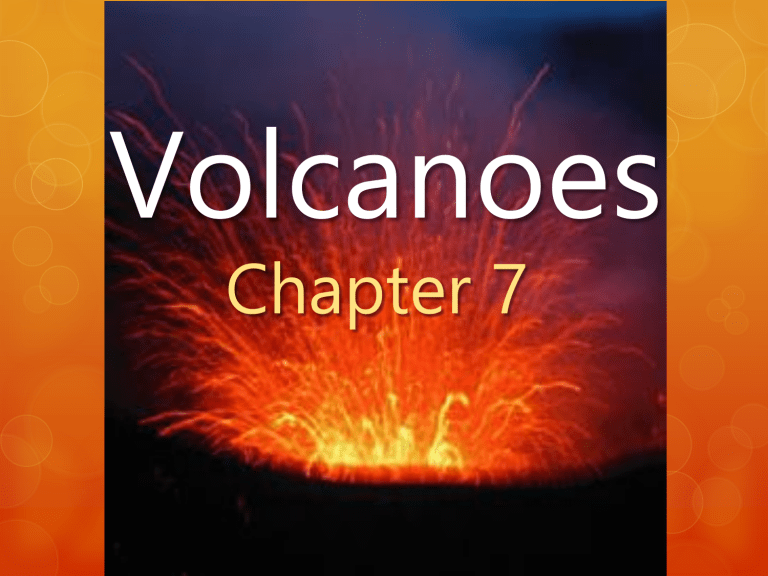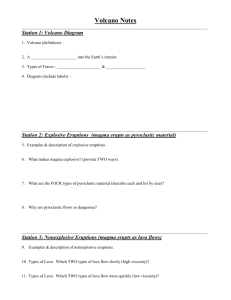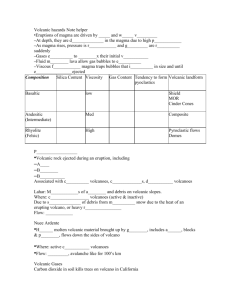Chapter 7

Volcanoes
Chapter 7
The Big Idea
Volcanoes are locations where magma reaches Earth’s surface. They affect human and wildlife habitats.
Lesson 1: Volcanoes and Plate Boundaries
Most volcanic activity occurs along plate boundaries where plates move relative to one another.
Lesson 2: Volcanic Eruptions
Earthquakes cause seismic waves that provide valuable data.
Lesson 3: Hazards of Volcanic Eruptions
Volcanic eruptions can change human and wildlife habitats.
Lesson 1: Volcanoes & Plate
Boundaries
Most volcanic activity occurs along plate boundaries where plates move relative to one another.
What you’ll learn:
• Explain what causes volcanic activity.
• Relate the location of volcanoes to plate boundaries.
So What?!
Understanding how volcanoes form and where they occur helps scientsts predict volcanic eruptions.
Review Vocabulary
Lithospheric plate
A section of Earth’s crust and rigid upper mantle that moves slowly on the asthenosphere.
New Vocabulary
A volcano is a land or an underwater feature that forms when magma reaches the surface of Earth. The opening through which magma escapes from a volcano onto Earth’s surface is called a vent . During a fissure eruption , magma escapes through cracks in Earth’s surface.
Most volcanoes occur along plate boundaries, but some form from localized inside Earth.
hot spots areas of heat called hot spots that occur
Academic Vocabulary source Point of origin
* We found the source of the leak to be the hole in the pipe.
What Is A Volcano?
What Is A Volcano?
Distinguish magma from lava.
Magma
Magma is molten material that forms igneous rock. It is INSIDE of the Earth!
Lava
Lava is magma that has reached Earth’s surface.
How Do Volcanoes Form?
Sequence the events that occur as a volcano forms.
Heat deep inside Earth causes rock to melt, forming magma
Magma rises because it is less dense than surrounding rock.
Magma reaches
Earth’s surface and flows out through a vent, becoming lava.
A cone-shaped landform develops from the lava that pours onto
Earth’s surface.
How Do Volcanoes Form?
Organize information about fissure eruptions by completing the table.
Fissure Eruptions
When they occur
Where they occur
When magma escapes from cracks in Earth’s crust
At divergent plate boundaries
What they form
In oceans: mid-ocean ridges and new seafloor
On continents: rifts and new crust at
Earth’s surface
Summarize it!
Summarize the three main ideas of the above sections.
Where Do Volcanoes Occur?
Identify three places at which volcanoes often form.
1. At divergent plate boundaries
2. At convergent plate boundaries
3. At hot spots
Where Do Volcanoes Occur?
Compare & Contrast how volcanoes form at divergent and convergent plate boundaries.
At Divergent Boundary
When plates move apart, a huge crack forms between them.
Magma rises through the crack and reaches the surface.
The magma cools and hardens to form new crust.
At Convergent Boundary
When two plates are pushed together, one plate sinks beneath the other.
Magma forms as the plate sinks.
The magma rises to the surface forming volcanoes.
Where Do Volcanoes Occur?
Classify the types of plates involved in the formation of each group of landforms.
Island
Arcs
Volcanic Landforms at
Converging Plates include
Volcanic
Arcs that form where that form where
Two oceanic plates are pushed together
An oceanic plate sinks beneath a continental plate.
Summarize it!
Summarize the main idea of the above sections.
Lesson 2: Volcanic Eruptions
& Features
The composition of magma controls volcanic eruptions and determines the different types of lava flow and volcanic features
What you’ll learn:
• Relate the composition of magma to characteristics of volcanic eruptions.
• Compare and contrast different types of volcanoes.
• Analyze California’s volcanic activity.
• Differentiate between volcanic features.
So What?!
Understanding the composition of magma helps scientists better predict how volcanoes erupt.
Review Vocabulary
Landform
A cinder cone is a type of landform that results from volcanic activity.
Cinder Cone
Volcano
Tephra
New Vocabulary
Shield Volcano
Huge, gently sloping volcanic landform that is composed mainly of basaltic lava.
Steep-sided, cone-shaped landform that is composed mainly of solid fragments.
Solid fragments, including rocks and boulders, that erupt from a volcano.
Composite
Volcano
Mountainlike volcanoes that form from alternating layers of tephra and lava.
Academic Vocabulary emerge To rise from; to come into view
* The lava emerged from the vent of the volcano, escaping onto Earth’s surface.
What Controls Volcanic
Eruptions?
Identify three factors that affect how a volcano erupts.
1. Composition of magma
2. Amount of dissolved gases in magma
3. Temperature of magma
What Controls Volcanic
Eruptions?
Label the arrow to show how the amount of silica in magma affects its viscosity.
LOW VISCOSITY HIGH VISCOSITY
MORE
Types of Magma & Lava
Compare & contrast basaltic magma & lava and granitic magma & lava.
Basaltic Granitic
Silica
Content
Viscosity
Type of
Eruption low low
Quiet, nonexplosive high high explosive
Types of Magma & Lava
Contrast pahoehoe lava and aa lava.
Pahoehoe lava: Flows down side of volcano; develops a smooth skin and ropelike structure as it cools.
Aa lava: Flows at a lower temperature, is stiffer, and moves more slowly than pahoehoe.
Summarize it!
Summarize the main ideas of the above sections.
Volcano Types
Shield Cinder Cone Composite
Appearance:
Huge, gently sloping
Composition:
Mainly basaltic lava
Formation:
Layers of gently flowing lava pile up
Appearance:
Steep-sided, coneshaped
Composition:
Mostly solid fragmts
= tephra
Formation:
Explosive eruptions create tephra piles near vent
Appearance:
Tall, steeper than shield
Composition:
Lava and tephra
Formation:
Alt. quiet & explosive eruptions
= layers of lava & tephra
Types of Volcanoes
Model three types of volcanoes by drawing a cross-section of each in the boxes provided.
Shield
Volcano
Show a broad volcano with broad, flat layers and gently sloping sides.
Types of Volcanoes
Model three types of volcanoes by drawing a cross-section of each in the boxes provided.
Cinder Cone
Volcano
Show a steepsided, coneshaped volcano
Types of Volcanoes
Model three types of volcanoes by drawing a cross-section of each in the boxes provided.
Composite
Volcano
Show a steepsided mountain with alternating layers of lava and tephra
Summarize it!
Summarize the main idea of the above sections.
(Three types of volcanoes…)
Volcanoes in California
Complete the following paragraph.
Northern California
Volcanic Features
Identify features of intrusive volcanoes (see pages 308-309).
Intrusive Volcanic Features
Batholiths form when magma slowly cools and solidifies before reaching the surface.
Dikes are created when magma squeezes into cracks in rocks below the surface. The magma cuts across rock layers and hardens.
Magma that is parallel to rock layers and hardens is called a sill.
When a volcano stops erupting, magma hardens inside the vent.
Erosion wears away the volcano’s cone, leaving behind the igneous core as a volcanic neck.
After slowly erupting from the vent, granitic lava piles up instead of flowing freely.
Pressure builds up within the lava dome, and gas, lava, and solid materials can be violently
A hollow tube forms when lava flows through a channel, cools, and hardens on the surface.
Lava tubes often form underground and branch to the sea.
Features of Volcanoes
Oregon, USA
Stage 1 Stage 3
An Erupting volcano
Stage 2
A collapsed volcano with caldera
A caldera filled with water
Lesson 3: Hazards of
Volcanic Eruptions
Volcanic eruptions can change human and wildlife habitats.
What you’ll learn:
• Describe effects of volcanic eruptions on human and wildlife habitats.
• Discover geologic events that scientists observe and measure to help predict volcanic eruptions.
So What?!
As scientists become better able to predict and monitor volcanic eruptions, more lives and property are saved.
Review Vocabulary
Seismic Wave
A wave that travels through Earth generated by an earthquake.
Volcanic Ash
Lahar
New Vocabulary
Pyroclastic
Flow
Very fine-grained tephra
*During a volcanic eruption, large clouds of volcanic ash may be ejected over wide areas.
Rapidly flowing mixture of volcanic debris and water
*Large lahars often begin as landslides.
Fast-moving body of hot gases and solids released from explosive volcanic eruptions
*Pyroclastic flows can destroy everything in their path.
Academic Vocabulary release To set free from confinement
* Volcanoes release hazardous gases into the atmosphere.
Effects on Habitats
Organize information by listing six hazards of volcanic eruptions.
Hazards of
Volcanic
Eruptions volcanic ash landslides gases lahars pyroclastic flow lava flows
Effects on Habitats
Identify and Describe information about the harm that volcanic eruptions pose to habitats.
Volcanic
Hazard
Volcanic Ash
Landslides &
Lahars
Gases
Potential Damage to Human or
Natural Habitats
Causes structural damage; buries plants, animals, and their food sources.
Bury habitats
Pyroclastic Flows
Lava Flows
Mix with water to form acid precipitation
Burn or bury habitats; release gas that contaminates air
Burn or bury habitats; release smoke that damages air quality
Summarize it!
Summarize the main idea of the above sections.
Predicting Volcanic Eruptions
Analyze why each sign listed can be used to predict possible volcanic activity.
Small
Earthquakes
Small earthquakes can occur as magma is forced up through brittle rock.
Gas
Emissions
Different amounts of gases indicate how far beneath the surface magma is located.
Ground
Movement
Temperature
As magma is forced upward, the ground may rise or bulge slightly.
As magma moves toward the surface, the temperature of the ground around the volcano may increase.
Monitoring Volcanic Activity
Identify three ways scientists monitor volcanic activity from space.
Monitoring Volcanic Activity from
Space
Satellite
Imaging
Radar
Imaging
GPS
Summarize it!
Summarize two main ideas of the above sections in two bullet points.
Mt. Vesuvius
Mt. Vesuvius







